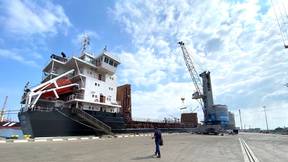A2SEA-owned jack-up leaves Damen Shiprepair Amsterdam able to handle bigger offshore wind installation projects
Damen Shiprepair Amsterdam (DSAm) has concluded major modification works on the Sea Installer. The principle scope of work involved the extension of the main crane boom, giving the A2SEA-owned offshore wind farm installation vessel increased reaching capacity: a pertinent point considering the trend of the increasing size of offshore wind turbine components. Other work comprised structural modifications as a consequence of the larger crane.
DSAm, part of Damen Shiprepair & Conversion, began the work by removing all crane-related components including the boom, boom rest, A-frame, winch and hook block pockets from the vessel. A2SEA supplied the new A-frame and boom extension. Niron Staal, also part of Damen Shiprepair & Conversion, supplied the new boom rest, hook block pockets, trolley rail and support stools.
The crane boom was lengthened by inserting the new extension. The fact that all elements were composed of high tensile S690 steel had its consequences to the timing of the project. Damen Junior Project Manager Remco van Dam informs: “This material requires distinct and carefully planned procedures. You can cut it when it’s cold, but, before you weld it, you need to heat it with heating elements to 200°C to remove any traces of water.”
“Then, after slight cooling, the welding itself needs to take place at the correct temperature in a protected environment. For this, we constructed air-tight welding tents.”
Once complete, the weld in question was cooled prior to non-destructive testing after 48 hours. “We also performed our own initial checks after 24 hours in case any additional welds were needed. The main point with S690 is that you cannot rush things. If you go too fast, it can set you back three days.”
The configuration of the upgraded crane is such that it can be operated in two modes: a long mode with the crane boom extension in place, and a short mode with the extension removed. The Sea Installer now has a flexible crane capacity of 900 metric tons in short mode and 700 metric tons in long.
Two mobile Mammoet cranes lifted the extended crane boom back onto the vessel. To create a stable lifting foundation – allowing for a maximum of 0.3 degrees of tilt – the quayside was leveled prior to the vessel’s arrival at the yard. This required laying no less than 800 cubic meters of sand, topped off with 750 dragline crane mats.
Installing the larger crane on the Sea Installer had numerous implications on existing on board structures. The boom rest had to be replaced, which in turn necessitated additional modifications to the accommodation area. In order to house the main hook and auxiliary hook in both long and short mode, the existing auxiliary hook block pocket was replaced with a new construction that comprised one main and two auxiliary hook block pockets.
The bigger crane also needed a bigger winch: DSAm replaced the existing winch with a larger, 900-tonne capacity, winch. This included all the necessary adjustments of the electrical, hydraulic and cooling systems. The vessel’s main mast also needed structural modifications.
With the 132-meter-long vessel at the yard, DSAm also executed various standard maintenance jobs such as painting, pipe renewal and thruster inspection.
As is standard working practice at DSAm, safety issues were top of the agenda for yard personnel and the vessel’s crew, who remained on board throughout the modification works. Daily meetings commenced with discussion of safety issues and heavy lift events were given special attention in so-called ‘tool-box’ meetings.
The smooth running of the entire project was facilitated by the joint efforts of the DSAm and A2SEA personnel. “It has been a pleasure to work with the ship’s crew,” Van Dam concluded. “There has been good communication throughout and this has helped us in many ways. For example, their involvement in adjusting the ship’s ballast tanks during such a heavy lift was crucial.”

